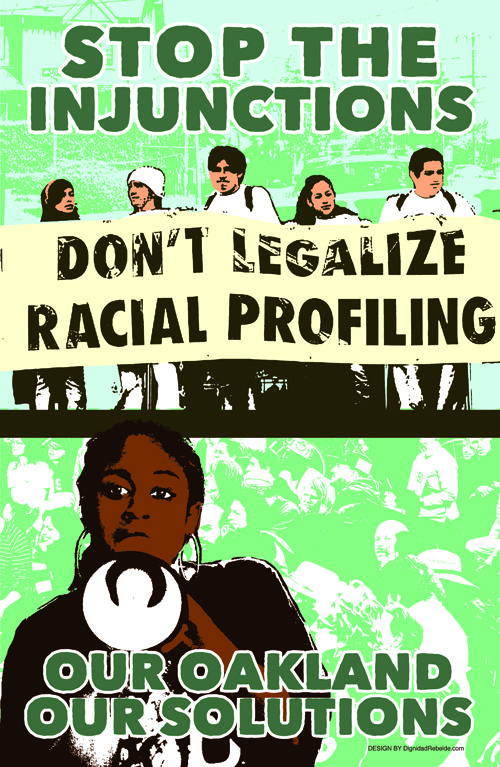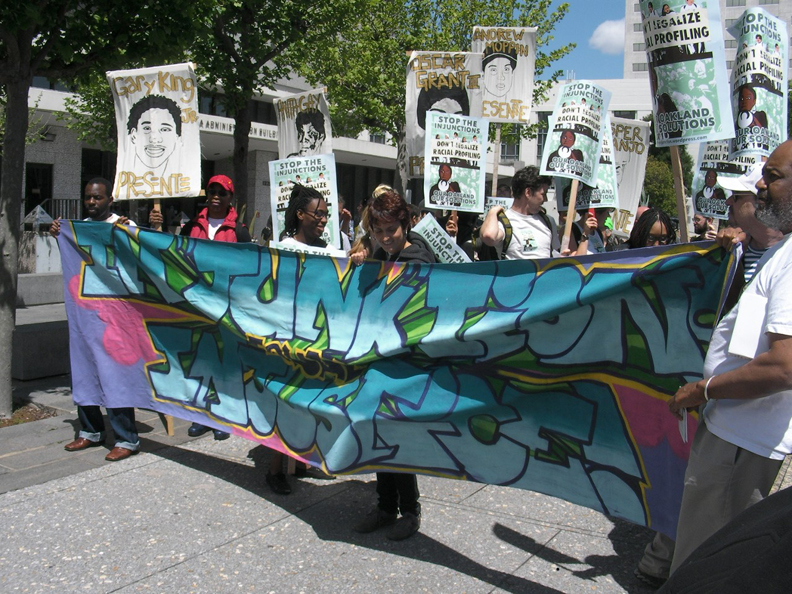CR Oakland member and Stop the Injunction Coalition organizer reflects on the ways in which CR has used art in our campaign to defeat gang injunctions in Oakland.
Memory and Vision: Resisting Displacement, Propagating Community Self-Determination
By Molly Porzig, CR Oakland
Critical Resistance has used visuals, images and other forms of art throughout our anti-policing work in Oakland, especially in our efforts with Stop the Injunctions Coalition (STIC) to stop the use of gang injunctions. We’ve used images, visuals and art to illustrate the ways gang injunctions and policing devastate and target our communities. We also use visuals, images and art to envision what our communities actually need and what we’re fighting for.
Our Oakland Our Solutions Poster:

The above “Our Oakland, Our Solutions” image, is a poster that has became STIC’s main campaign poster. The image was created by our ally Melanie Cervantes from Dignidad Rebelde. The image was inspired by a rally STIC organized as part of a week of action to stop gang injunctions in Oakland in March 2011. At this rally, over 800 people gathered in downtown Oakland. Nearly 200 of whom were youth who walked out of schools across East Oakland, shutting down nine major intersections on their way to the rally. Melanie took photographs of rally participants that day and used them as inspiration for this image (The row of youth in front with drums are young people from allied organization AYPAL). The poster illustrates both the community power STIC is building, as well as the ultimate goal of STIC’s work: community self-determination.
In STIC, CR has worked to generate people’s propaganda to counteract the well-resourced propaganda machine of the Oakland Police Department and City Attorney’s office. We’ve done this by creating images that depict the real costs and impacts of gang injunctions.

This image was designed by CR and STIC member, Lisa Nowlain, depicting Chief Anthony Batts of the OPD and City Attorney John Russo riding a bull-dozer that is destroying people’s homes. The image identifies two of the main proponents of gang injunctions in Oakland, showing where their interests lie with gang injunctions. This image also demonstrates that, as a major policing strategy, gang injunctions work to gentrify working class communities and communities of color, displacing working class and people of color by pushing them out of their neighborhoods. The North Oakland injunction, for example, has resulted in every person named in the injunction (all of whom are young black men and Asian/Pacific Islander men) currently being locked up or having pushed out of the neighborhood by the injunction. While we have successfully stopped the expansion of gang injunctions in Oakland and held the City to only two temporary injunctions (Russo and Batts pushed for more than a dozen injunctions to be filed and implemented through Oakland), we have not been able to stop the displacement of people named in the injunctions. We did, however, build enough opposition and scrutiny of gang injunctions as well as tension between City Council and these two gang-injunction cowboys that we pushed both Batts and Russo out of Oakland and stopped City Council from considering more injunctions.

This image is the cover of a report Critical Resistance wrote detailing the costs and impacts of gang injunctions as well as examples of alternatives, services and responses to violence Oakland needs instead of increased imprisonment and policing. The report was a crucial tool used in pressuring City Council to squash any will for gang injunctions, as well as a tool in getting consistent, reliable media coverage of injunctions.
The cover image of the report is a photograph of three banners CR Oakland members made in 2009 that depict Plan for a Safer Oakland’s Three Point Plan. For years, CR Oakland had been in a partnership with our close allies, All of Us or None, called Plan for a Safer Oakland (PSO). Together we developed a three-point plan for creating truly safe communities in Oakland. The first point of the plan is to provide re-entry support and services for people returning from prison. The second point of the plan is to invest in communities, not police and prisons. The third point of the plan is to stand up with youth. PSO’s Three Point Plan and the work of PSO has greatly influenced how many people in Oakland understand and fight for safety, or healthy, vibrant, sustainable communities. More so, PSO’s three-point plan greatly influenced the demands, vision and strategy of STIC’s work and CR Oakland anti-policing work generally. The banners hang in CR Oakland’s office, and members often take the banners with them to events and demonstrations.

This last image is a photograph of a rally outside the Oakland courthouse against the North Oakland Injunction in 2010. This photo demonstrates some ways we’ve used art in our grassroots organizing. The banner “Injunktions equal Injustice” was a banner made by youth at Eastside Arts Alliance. The blue posters behind are another image by Melanie Cervantes, and were the first poster STIC used when it began fighting the North Oakland injunction in 2010 (joining with allies in East Oakland to fight the Fruitvale injunction later that year). The third type of banners seen in this photo, each with a name on top, a face and “Presente” on the bottom, honor a person killed by police in Oakland. CR Oakland members made the “Presente” banners in 2009 after Oscar Grant was killed by BART police, to honor Oscar Grant and his family, and to underline the system of policing’s continued attack on communities of color throughout Oakland, claiming countless victims including Gary King Jr., Anita Gaye, Casper Banjo, Andrew Moppin. CR Oakland members bring the “Presente” banners to rallies and demonstrations frequently to keep the violence of policing through memories of those we have lost at the foreground.
